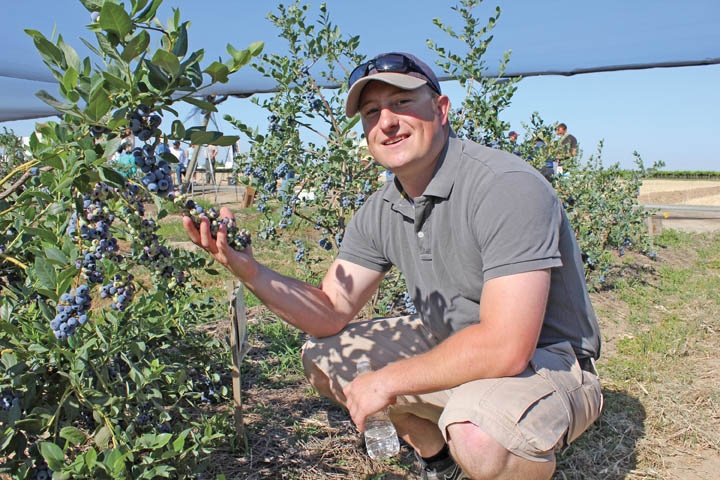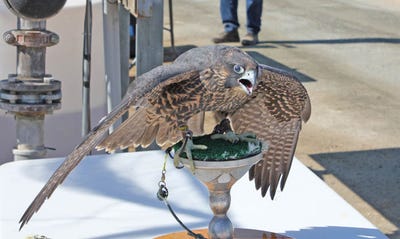
Blueberry harvest in high gear
The blueberry harvest is in high gear in California, where it’s estimated more than 40 million pounds will be harvested this season. And the North American Blueberry Council estimates the continent’s blueberry production this season has surpassed the half billion pound mark for the first time in history.
June 11, 2012

A young, screeching falcon shared the bill with juicy blueberries for tasting during a field day that served as further evidence that the challenging crop is alive and well in California, not exactly the most hospitable place to grow the tasty fruit.
In California, challenges include the fact that blueberry plants are much happier with a soil pH of 4.5 to 5.5. It’s common that soils in California’s growing regions are significantly higher than pH 5.8, and that can result in iron chlorosis and reduced blueberry plant growth and yield.
While the falcon can be hired to keep other pesky birds from swiping the sweet fruit, other steps must often be taken well out of view to help plants thrive in California, including acidification of soil or irrigation water.
The University of California Kearney Ag Center in Parlier, the location for the blueberry open house and tasting, continues to hold a special place for research on blueberries with a plot that has more than 60 varieties, including what researcher Manuel Jimenez calls “senior citizens” going back 15 years.
Jimenez, Tulare County farm adviser with UC, talked of his newest research effort to determine how well some varieties may do if they are grafted onto a native species called Viccinium abroreum that does well in soils with higher pH levels.
The study is also looking at whether plants on that rootstock will do well in areas without added organic materials. It’s common for growers in California to add organic matter as mulch when first planting and replacing those materials as often as every other year.
Separate studies at Kearney have found that agricultural waste products such as pecan and walnut shells, pine shavings, almond wood chips are good for mulching.
Emerald, Jewel and Star cultivars have been grafted onto the arboretum stock in the field, and the small, young plants are a sharp contrast to the bushy ones under shade cloth in a neighboring plot.
“We will recommend grafting in the nursery, not the field,” Jimenez said. Some plants did not survive field grafting at the Parlier center.
Separately, the University of Florida is also conducting grafting research to the same rootstock because it may offer higher pH tolerance, a deeper root system, a single trunk growth characteristic and higher drought tolerance.
The blueberry harvest is in high gear in California, where it’s estimated more than 40 million pounds will be harvested this season. And the North American Blueberry Council estimates the continent’s blueberry production this season has surpassed the half billion pound mark for the first time in history.
It’s a busy time for falconers like Fred Seaman, chief executive officer of Atascadero-based Airstrike Bird Control. The company uses falcons to chase away pest birds from crops that include blueberries and grapes.
Like crack to birds
“Blueberries are like crack to birds,” Seaman said as he showcased a falcon in training. She is less than two months old and named Anna Karenina. Common pests that can pilfer the berries include Starlings and Cedar Waxwings.
 Many mature plants at the UC center were ripe for the picking as Jimenez walked among them, describing their good and bad points. He said the Misty and Sharpblue varieties were probably best suited to home gardeners.
Many mature plants at the UC center were ripe for the picking as Jimenez walked among them, describing their good and bad points. He said the Misty and Sharpblue varieties were probably best suited to home gardeners.
Misty, he said, is not a good commercial variety because it is “too late, too small, and its management is not simple. The canes want to lie down.”
The Jewell variety, he said, is “early and large but soft.”
“The perfect blueberry would be one that is big, firm, sweet, easy to harvest and grows in high pH,” he said.
Someone added, “And makes you a whole lot of money.”
Jimenez said the Star is the only variety that features berries of the same size through multiple pickings. Other varieties have berries of smaller sizes after the first picking.
Top commercial varieties include the Jewel, Emerald and Star. Those favored in the tasting during the field day were the Southmoon, Reveille and Biloxi.
Richard Molinar, UC small farm adviser in Fresno County, who conducted the tasting, said there is a wide range of characteristics for blueberries depending on variety — from sweet to tart.
“Flavor is also affected by weather, soil factors, plant nutrition, and irrigation frequency,” Molinar said. “An exceptionally good tasting variety one year might be only mediocre the next.”
Top commercial varieties are likely to change over time, said Dick Mombel, commercial sales manager with Fall Creek Farm and Nursery Inc. in Lowell, Ore., which has established its own breeding program.
“In 10 years, we’ll be looking at new varieties in the top five,” Mombel said.
Molinar said some of the earliest recommended varieties for the San Joaquin Valley included Reveille and Georgia Gem. “Then came Star, Oneal and Misty as good choices,” he said. “Now, Emerald, Jewel, and Springhigh are the new kids on the block, along with Snowchaser.”
Growers select varieties based on criteria that include when they bear fruit, flavor, yield, adaptation to a particular region or soil, shelf-life and adaptation to mechanical harvesting.
Mombel and Jimenez estimated there are about 5,000 acres of blueberries grown in California and both concurred it is one of the most challenging crops to grow in the state. That compares with less than 500 acres when the first bushes were planted at the Kearney center.
“Planting has leveled off,” Mombel said. And Jimenez said some acreage has been removed: “It’s still exotic for our climate.” Jimenez said high pH levels and perennial weeds have taken a toll in some instances.
Jimenez said some growers have a tendency to irrigate too much and to fertilize too heavily. “It’s better to fertilize in small increments; strong shots damage the roots,” he said. The first 12 months in the plant’s life are especially critical, Jimenez said, adding that is vital to measure soil moisture and pH levels.
Blueberries have a shallow root system of about 18 inches, making irrigation management crucial. Jimenez and Larry Schwankl, a UC irrigation specialist, have teamed to study the effects of varying irrigation levels on blueberries.
As for pruning, Jimenez said, “Prune hard, leave new canes.”
About the Author(s)
You May Also Like



